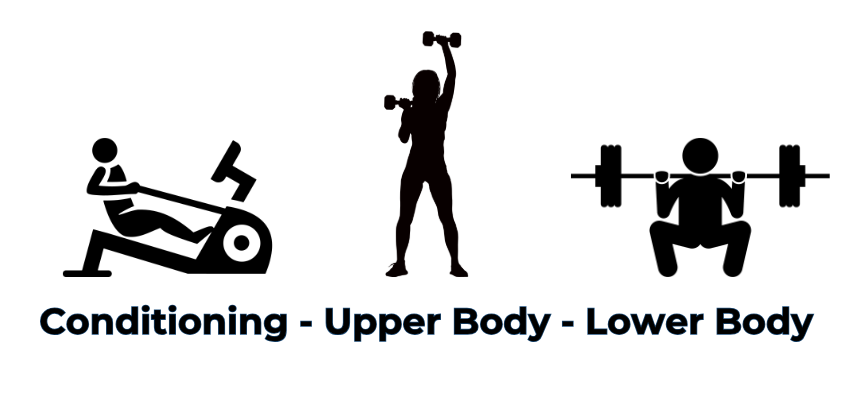How to Structure an Effective 30-Minute Workout (Even With your Busy Schedule)
Life as a parent is non-stop. Between work, diapers, the dreaded grocery store, and everything else, finding a full hour to train seems impossible some days. But here’s the thing: you don’t actually need that much time.
A focused 30-minute workout can build strength, get your heart rate up, and keep your musculoskeletal system primed—if you structure it correctly. And being very real: 30 minutes is INFINITELY better than nothing. And hey, if shorter workouts help you stay consistent, you should lean into them! Consistency—not perfection—is what delivers long-term results and 30 minutes makes that much more tenable.
Here is a simple, efficient, and effective 30-minute workout framework—so you have the option to train when your schedule allows.
30 Minutes is more than enough
It doesn’t always matter how long you train—it matter how intensely you train. A focused 30 minutes can check a bunch of boxes: build strength, elevate your heart rate, and torch calories if it is smart, high-intensity programming.
It’s also worth noting that consistency beats flash every single time and showing up for 30 minutes every day beats the occasional “perfect” 90-minute workout. In health, momentum is everything. The more often you train, the stronger, fitter, and more capable you stay. Stop waiting for the perfect window. This is how you can train effectively with the time you’ve got.
A Killer Half-hour Framework
Here’s how to keep it simple:
10 minute Warm Up AMRAP
10 minute Pull AMRAP
10 minute Push AMRAP
That’s it. Three blocks. Ten Minutes.
The warm-up circuit gets your joints moving, your primary muscles firing, and your heart rate elevated so you’re not going into the work cold. Then, the two primary circuits pair strength and conditioning to hit your whole body: lower, upper, and something that gets you breathing heavy.
Each block is run as an AMRAP—As Many Rounds As Possible—which is a secret weapon for when you’re in a time crunch. Set a timer for 10 minutes, cycle through 3 movements, and get in as much hard work as you can. You control the pace — push harder on days you’ve got energy, or take it steady when life is a little much. The key is showing up, moving with intention, and staying consistent. That’s how to stack wins.
The 10-Minute Warm-Up
Your warm-up doesn’t need to be complicated, but it does need to prep your body for what’s coming. We’ll use a simple formula: pick one movement for each of these five categories and run them as an AMRAP (As Many Rounds As Possible) for 10 minutes. Do 10 reps per movement at a smooth, controlled pace. It’s a simple structure that pays dividends in short workouts.
Here’s the 5 movement formula:
Mobility Exercise – active stretching to open up stiff joints and improve range of motion.
Core Activation – wake up your midsection so it can stabilize your spine.
Hip Activation – get the glutes and hips firing for strong lower-body work.
Shoulder Activation – prime your upper body for pushing and pulling.
Integrated Movement – tie it all together with a full-body pattern.
Repeat for as many rounds as you can in 10 minutes. Most parents will get through 2-3 rounds, which is plenty to elevate your heart rate, activate key muscles, and prime your body for the work ahead.
The Primary Circuits: Two 10-Minute AMRAPs
After your warm-up, it’s time to get to the work. The beauty of this framework is in its simplicity: two back-to-back AMRAPs that combine conditioning and strength to hit your entire body in just 20 minutes.
Each 10-minute block follows this formula:
The 3-Step Primary Circuit Formula
Conditioning Movement – 30–60 seconds (or a set number of reps)
This gets your heart rate up and keeps the intensity high.
Upper Body Strength Movement – 15 reps
Focus on controlled, quality reps to build and maintain strength.
Lower Body Strength Movement – 15 reps
Target the big movers—quads, glutes, hamstrings—with compound patterns.
Set a timer for 10 minutes and cycle through these three movements as many times as you can with good form. Rest as needed, but aim to keep moving.
Example: Circuit 1 – Pull Focus
Example: Circuit 2 – Push Focus
This structure balances strength and cardio while keeping things flexible. You can swap exercises based on what equipment you have or how your body feels that day. The goal is quality movement and steady effort—not racing the clock.
Simple. Effective. Doable.
You don’t need hours in the gym or a complicated plan to become more capable in your daily life. This 30-minute framework gives you everything you need: a solid warm-up, strength for your upper and lower body, and enough conditioning to get your heart rate up and calories burning. You can do it at home, in the gym, or wherever you can carve out a little time for yourself—likely while the kids are napping.
So don’t wait for the perfect schedule or a quiet house. Set a timer, start your warm-up, and get moving. You’ll be surprised at how much stronger and more energized you feel with just 30 minutes a few times a week.





